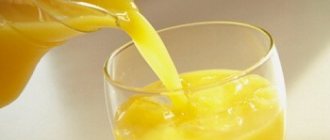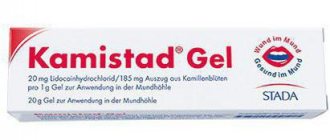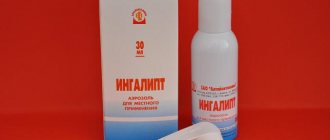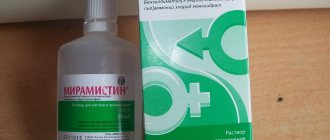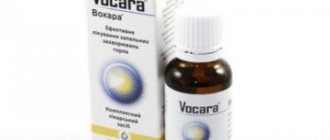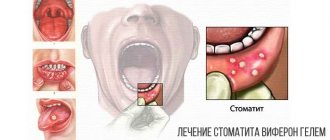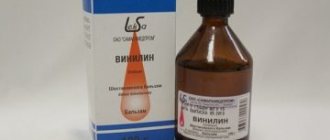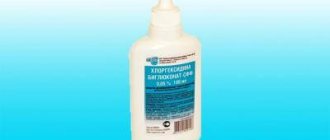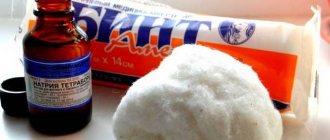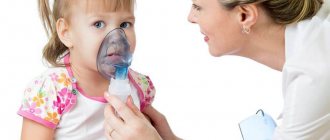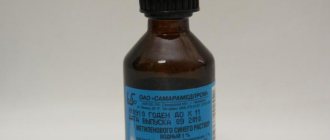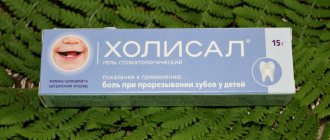Composition and pharmacological action
The drug is based on anhydrous choline salicylate, which makes up 87%.
In addition, 10% is cetalkonium chloride, and the remaining 3% are excipients.
Among them: ethyl alcohol, glycerin, purified water, hydroxyethylcellulose, propyloxybenzoate, anise oil, methyloxybenzoate.
Cholisal is a combination drug that provides:
- pain reliever;
- anti-inflammatory;
- antimicrobial action.
The gel is widely used in dentistry to treat and alleviate multiple diseases.
Choline salicylate has a pronounced anti-inflammatory and analgesic effect on the application area. In acidic and alkaline environments, the substance has antimicrobial and antifungal effects. It quickly penetrates the nerve endings, as it is characterized by good absorption from the oral mucosa.
Dental gel
Cetalkonium chloride is an antiseptic. It affects fungi, viruses, gram-positive and gram-negative microorganisms. Methyloxybenzoate and propyloxybenzoate also have antifungal and antibacterial effects.
Due to the fact that Cholisal has a gel base, it reduces surface tissue tension, which facilitates rapid absorption of the active substance. In addition, the drug adheres well to the oral mucosa and is not washed off with saliva for a long time.
After the first application, the analgesic effect occurs within 3-4 minutes and lasts for 4-8 hours.
Indications and benefits
Indications for the use of Cholisal primarily include stomatitis, periodontitis, traumatic damage to the oral mucosa caused by constant wearing of dentures and surgical treatment of diseases of the oral cavity.
Cholisal has also found wide use in pediatric dentistry as an excellent analgesic for teething and in the treatment of stomatitis of various etiologies.
Benefits of Cholisal
This drug is also widely used as one of the components in the treatment of Steven-Johnson syndrome.
Cholisal has a number of advantages.
The main ones include the following.
- Gel consistency. Water is used as a base in such preparations, due to which the preparation is absorbed very quickly and does not leave an oily aftertaste. In addition, this texture allows it to adhere to the mucous membrane in the form of a thin film that protects against the penetration of pathogenic microorganisms.
- The second advantage is the combined composition of the drug, which makes it more effective than other similar drugs. Choline salicylate, the main active ingredient of Cholisal, effectively relieves inflammation and has a pronounced analgesic and antipyretic effect.
- Cetalkonium chloride, another component of the gel, is an antiseptic. Its main function is to destroy bacteria, viruses and fungi that have entered the oral cavity.
Thus, Cholisal is an excellent remedy that replaces several drugs at once. It not only relieves inflammation and pain, but also destroys pathogenic microflora.
Most similar drugs have a strictly targeted effect (antimicrobial or analgesic) and the treatment of a particular disease requires the prescription of two or more drugs.
The gel has a triple effect: antimicrobial, analgesic and anti-inflammatory.
Indications for use
In addition to the fact that Cholisal relieves pain and reduces the number of fungal and viral microorganisms in the oral cavity, it is also widely used in the treatment of a number of other diseases.
In particular:
- Candidiasis;
- Radiation sickness;
- Gum pathologies;
- Stomatitis.
The drug is prescribed for the treatment of any type of stomatitis, both in adults and children. A feature of Cholisal gel is the absence of allergic reactions.
It is recommended to use the drug in the treatment of stomatitis in children over one year of age. At an earlier age, the doctor may prescribe Cholisal, but it must be used with extreme caution and under the strict supervision of a pediatrician.
Conditions of release and storage
To purchase the medication "Cholisal", you do not need a prescription from your doctor. The instructions for use say that it is important to store the pharmaceutical product in a dry and cool place, protected from direct sunlight and children. The temperature in such a room should not exceed 25 °C. It is permissible to store the medicine for no more than 3 years from the date of release, the date of which can be found on the Cholisala packaging. After the expiration date, it is prohibited to use the drug, as it is fraught with the development of adverse reactions.
How to use?
Before using the gel, wash and dry your hands thoroughly. The drug is squeezed onto the finger in a small amount and thoroughly rubbed into the oral mucosa. When treating children aged 1 to 12 years, it is recommended to use 0.5 cm of gel for each treatment. For adults and children over 12 years of age, the dose is 1 cm of the drug.
For aphthous and acute bacterial stomatitis, you should start using Cholisal gel from the first days of detection of the disease, since the substances included in the drug have a detrimental effect on the causative agents of stomatitis.
Signs of stomatitis
To relieve pain, the gel is applied 2-3 times a day after eating directly to the affected areas of the mucosa. It is also recommended to treat the oral cavity before going to bed. Treatment of the disease at the second stage involves replacing Cholisal with wound healing agents.
The drug has an excellent effect in the treatment of chronic and acute candidal stomatitis. This is due to the high efficiency of its constituent substances in acidic and alkaline environments. After all, in order to get rid of fungus, it is recommended to rinse your mouth with a 1 percent soda solution, which creates an alkaline environment.
Dentists often prescribe Cholisal to their patients for chronic stomatitis, in the presence of aphthae, ulcers, swelling and extensive inflammation.
Types of stomatitis in children
Depending on the cause that caused the inflammation of the oral mucosa, the following types of stomatitis are distinguished.
Viral.
This type of stomatitis occurs most often. The virus is transmitted by airborne droplets, through toys, dishes, and household items. At first, the disease is often confused with a cold: the child becomes lethargic, the temperature may rise, a runny nose and cough may appear. Moreover, viral stomatitis often occurs against the background of various acute respiratory viral infections, for example, influenza, measles, chickenpox. Around the second day, aphthae begin to appear on the gums, inside of the cheeks, tongue or lips - small round ulcers of a light yellow hue with a bright red border. That is why such stomatitis is also called aphthous or ulcerative.
Bacterial.
This stomatitis often accompanies tonsillitis, sinusitis, and pneumonia. It can be recognized by the formation of a thick yellow crust on the lips, which tightens the red border, preventing the child from opening his mouth wide. Bacterial stomatitis often occurs as a result of decreased immunity and may be accompanied by an increase in temperature.
Traumatic.
Such stomatitis is caused by mechanical injuries to the oral mucosa, for example, biting the inside of the cheek or lips, burns from hot food, the habit of gnawing hard objects, etc.
Candida.
This stomatitis most often occurs in infants. The cause of its appearance is a fungus of the genus Candida. The fact is that breast milk, which remains in the baby’s mouth, is a favorable environment for the proliferation of this microorganism. Such stomatitis can be suspected by a persistent white cheesy coating in the oral cavity, under which red irritated tissue is hidden.
Advantages and disadvantages
The main advantage of this drug is its gel structure.
Unlike ointments, which are based on animal or vegetable fats, the gel has a water base.
Thanks to this, it is perfectly absorbed in the shortest possible time, leaving a thin membrane on the mucous membrane that protects the affected areas from pathogenic microorganisms entering them.
This drug also has a drawback - increased salivation when using it. Anise oil, which is part of the gel, stimulates the functioning of the salivary glands. Of course, for an adult this is a small problem, but if the question is about treating stomatitis in a child, then difficulties may arise.
Instructions for Cholisal for stomatitis
The gel is applied topically, directly to the pathological focus. Before use, be sure to wash your hands, squeeze a small amount of gel onto your finger and rub with smooth massage movements into the affected area. The gel should be applied either 15 minutes before meals or after meals. You need to rub the drug in twice or thrice a day.
If stomatitis is diagnosed in children, then the amount of squeezed out gel should not exceed 0.5 cm. For stomatitis in adults, the tape should be 1 cm.
Contraindications and side effects
Despite numerous indications for use and a wide range of diseases for which the gel can be used, it still has some contraindications:
- Not recommended for children under 1 year of age.
- Pregnant and breastfeeding women.
- Prohibited in case of individual intolerance to one of the components of the drug.
An overdose of the drug in the treatment of stomatitis is impossible. This is due to the low systemic absorption of the active substances of Cholisal. Side effects include a slight burning sensation at the application site for 10-15 minutes after application. However, this is not a reason to stop using the product.
If a child or adult has hypersensitivity to salicylate, then some complications are possible:
- skin rashes;
- tinnitus, migraines;
- nausea, vomiting;
- increased sweating.
Today there are many analogues that are lower in cost. However, among all kinds of gels for treating stomatitis and relieving pain in the oral cavity, Cholisal is one of the most effective drugs.
Analogues of Cholisal gel for children and adults
The effectiveness and high degree of safety of this drug have made it a frequent resident of home medicine cabinets, but the price is not the most affordable - about 350-400 rubles. – forces you to look for analogues of Cholisal gel that are cheaper, but with the same scheme of action and the same obvious result. What do pharmaceutical companies offer?
- Cholisal has no absolute budget analogues in gel format. Its only complete replacement is Mundizal gel, but it is sold in 8 g tubes and costs about 300 rubles. It is less common in pharmacies than Cholisal.
If we are not talking about combination drugs, you can try to select several medications, or act on the problem with only one goal: to relieve inflammation, relieve pain, or provide an antiseptic effect. In this case, it makes sense to consider the following drugs:
- MetrogilDenta - works well for mucosal lesions, stomatitis, periodontitis, etc., but does not provide pain relief. It contains an antibiotic, so it is not used in children under 6 years of age. The price of the tube is 190-200 rubles.
- Periodontitis - suitable only for adults, gives an anti-inflammatory effect. Mainly recommended for gum injuries. Price – 150 rubles, tube volume – 15 g.
- Dentamed. Based on metranidazole (antibiotic), therefore used with caution in children. For 45 g the manufacturer asks 140 rubles.
- Kamistad. A good option for small children during teething, because... easily relieves pain due to lidocaine, and chamomile extract soothes and relieves inflammation. Price – about 240 rubles.
There are no complete cheap analogues of Cholisal gel for children and adults, and you can only find a budget replacement with a truncated spectrum of action. If you only need to relieve pain in a teething baby, buy Kamistad gel. In case of serious diseases of the oral cavity, it is better to spend money on Cholisal rather than try to combine several drugs to achieve the same effect.
What to choose: Cholisal or Metrogyl Denta
Many people cannot choose a drug for the treatment of stomatitis: they do not know what is better to buy - Metrogyl Denta or Cholisal. The deciding factor is the price in pharmacies. The price of Cholisal is about 400 rubles per 10 g tube, while Metrogyl Denta is just over 200 rubles. Metrogyl Denta contains chlorhexidine and metronidazole. These components negatively affect pathogenic bacteria, but do not have the same anti-inflammatory effect as the drug in question.
Metrogyl Denta, although it has satisfactory antimicrobial activity, does not have an analgesic effect. Cholisal is preferable for stomatitis. The drug destroys bacteria, relieves pain, and significantly reduces inflammation in the first days of the development of the disease.
How to increase the effectiveness of stomatitis treatment
To quickly ease your health during an exacerbation of the disease, it is recommended to start using Cholisal for stomatitis on the first day of illness. This will stop the proliferation of pathogenic microorganisms that provoke the inflammatory process. Also, early treatment prevents complications and the spread of infection to healthy tissue.
Throughout the treatment, it is important to use modern antiseptic solutions for rinsing the mouth. It is best to use Miramistin or Chlorhexidine.
Antiseptic solutions wash away pathogens, helping to quickly suppress the inflammatory response. It is recommended to apply Cholisal just after treating the oral cavity with an antiseptic and drying the tissues with sterile gauze.
